P&R I Classification
Moderador: Rein
Re: P&R I Classification
Rein:
I have loaded high resolution images to somestamps, and amongst these I have scans of blocks of four of the 1p and 2p 2D:
http://somestamps.com/domain-argentina/ ... lution.htm
I have loaded high resolution images to somestamps, and amongst these I have scans of blocks of four of the 1p and 2p 2D:
http://somestamps.com/domain-argentina/ ... lution.htm
sitio Ingles/Español de P y R I
http://www.somestamps.com/arg3551/index.htm
sitio general:
http://www.somestamps.com/
blog de P y R I en Ingles
http://arg3551.blogspot.com/
http://www.somestamps.com/arg3551/index.htm
sitio general:
http://www.somestamps.com/
blog de P y R I en Ingles
http://arg3551.blogspot.com/
- Rein
- Usuario Colaborador

- Mensajes: 6258
- Registrado: 13 Mar 2009 15:59
- Ubicación: Leiden, Netherlands
- Contactar:
Re: P&R I Classification
Tony,rubiera escribió:Rein:
I have loaded high resolution images to somestamps, and amongst these I have scans of blocks of four of the 1p and 2p 2D:
http://somestamps.com/domain-argentina/ ... lution.htm
the 2p Frutas in the previous posting was exactly coming from that source
- Rein
- Usuario Colaborador

- Mensajes: 6258
- Registrado: 13 Mar 2009 15:59
- Ubicación: Leiden, Netherlands
- Contactar:
Re: P&R I Classification
An intriguing stamp coming form Tony's high-definition scans is the following:
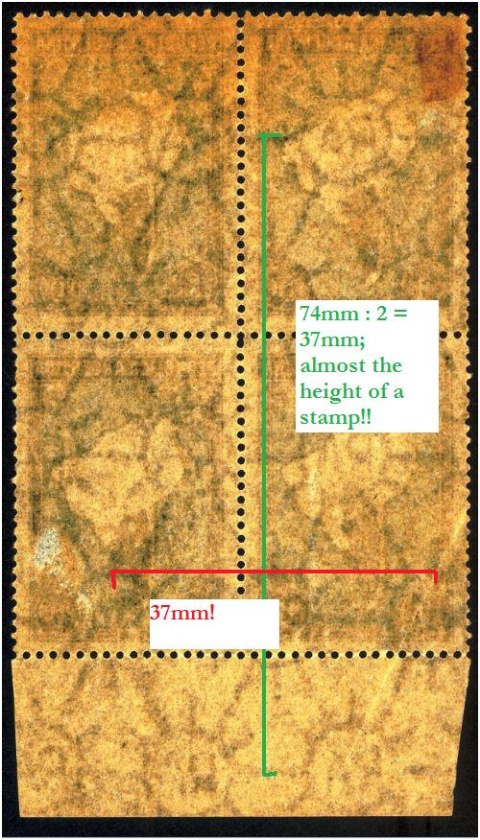
For a 2D we need a symmetrical paper mesh! In this scan it is not possible to see the mesh! The watermark has measurements that are higher and wider than we are used to! 37mm instead of 35mm for a Rayos Rectos [either difusos or nitidos]!
Is this real are are we making a mistake????
The assumption was that the height of a stamp was 37.5mm and the width 26.0mm; using the longest distance in this scan and setting the height of this block on 75.0mm we get to the measurements we have in the picture!
But when we take the double width of 52.0mm we get only a horizontal distance of 36.0mm?!?!?
The answer lies in the type of comb perforation that goes from bottom to top and produces a mini-tooth at the top of each stamp! Our assumption of a height of 37.5mm was wrong! There is NO variation in the width however! Hence a correct distance will be a bit closer to 35mm in both directions but not completely!!!
rc2375

For a 2D we need a symmetrical paper mesh! In this scan it is not possible to see the mesh! The watermark has measurements that are higher and wider than we are used to! 37mm instead of 35mm for a Rayos Rectos [either difusos or nitidos]!
Is this real are are we making a mistake????
The assumption was that the height of a stamp was 37.5mm and the width 26.0mm; using the longest distance in this scan and setting the height of this block on 75.0mm we get to the measurements we have in the picture!
But when we take the double width of 52.0mm we get only a horizontal distance of 36.0mm?!?!?
The answer lies in the type of comb perforation that goes from bottom to top and produces a mini-tooth at the top of each stamp! Our assumption of a height of 37.5mm was wrong! There is NO variation in the width however! Hence a correct distance will be a bit closer to 35mm in both directions but not completely!!!
rc2375
- Rein
- Usuario Colaborador

- Mensajes: 6258
- Registrado: 13 Mar 2009 15:59
- Ubicación: Leiden, Netherlands
- Contactar:
Re: P&R I Classification
Wiggins Teape, UK, Paper Mills did provide a lot of stamp printers with their papers. Apart from the UK also for other countries like Argentina:
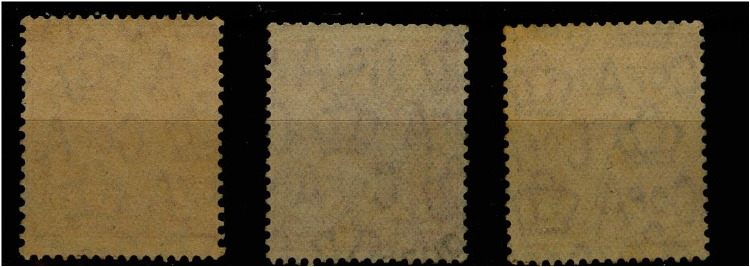
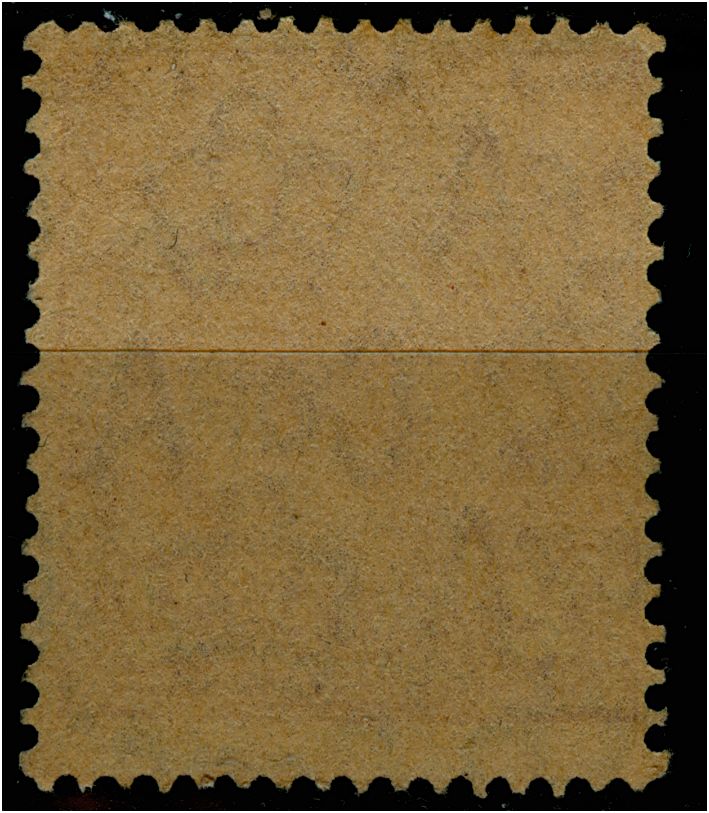
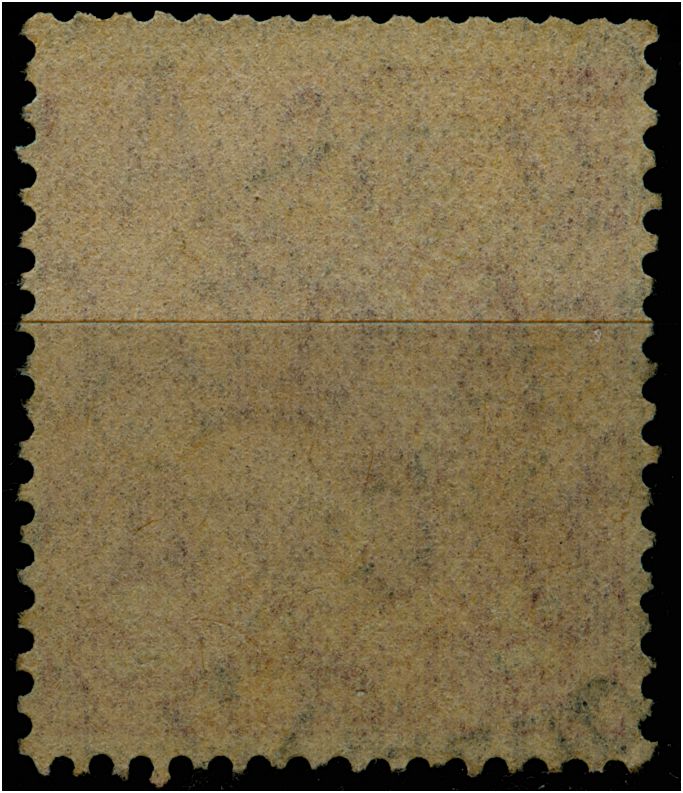
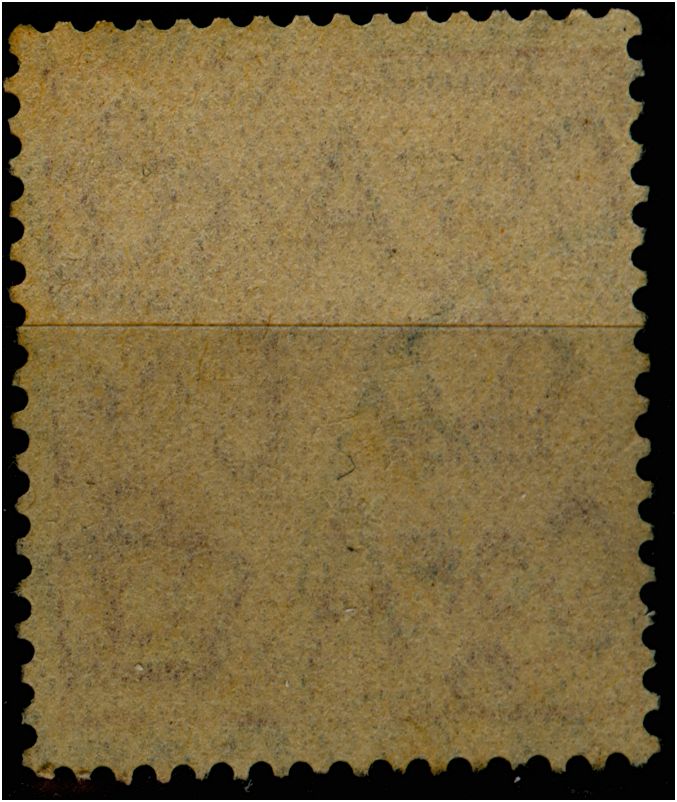
very similar to the 10c Rivadavia typography in red!
rc2378




very similar to the 10c Rivadavia typography in red!
rc2378
- Rein
- Usuario Colaborador

- Mensajes: 6258
- Registrado: 13 Mar 2009 15:59
- Ubicación: Leiden, Netherlands
- Contactar:
Re: P&R I Classification
SIR GOMEZ » Today 03:16 escribió:
Estimados, yo me estoy guiando por el catalogo Especializado de Dario Antonio Bardi y manejando esa nomenclatura, ahora bien, como se relacionan con la nomenclatura que ustedes estan usando... . Hay alguna diferencia o que alguien me puede ayudar en esto...
Saludos Sir Gomez
The concordance
Rubiera = Bardi
1E1 = MI 1 ! => MI 1a
1E2 = MI 2
1E3a = MI 1 ! => MI 1b
1E3b = MI 5 ! => MI 5a
1E3c = MI 4
1E4 = MI 3 and MI 7 (how the differentiate Mate Lustroso???]
2D = RR 1
2C = RR 2
NGR = SF 1 / SF 2 (Bardi had no way of denoting the direction of paper! SF 1 = SF 2!)
NOP = SF 3
CL1A = TI 1
CL1B = TI 2
CL2A = TI 3
.............
CL2B = TI 6
The Clay types of Tony do not quite match the TIZADO's of Dario. Tony has no TI 4 and TI 5. I think Dario is on the right track but will have some trouble to make it clear....
1L1 = MI 5 ! => MI 5b
1L2 = MI 6
1L3
1L4
1L5 = ZA 1
1L6 = ZA 2
ZA 3 and ZA 4 are beyond Tony's reach so far....
- Rein
- Usuario Colaborador

- Mensajes: 6258
- Registrado: 13 Mar 2009 15:59
- Ubicación: Leiden, Netherlands
- Contactar:
Re: P&R I Classification
Javier,juso » 19.06.2010 19:46 escribió:
Sarcosis le les des mucha importancia a la goma ya que con el tiempo se vuelve amarilla por diversos motivos y podes confundir un importado con un nacional, la diferencia fundamental es saber la filigrana de ambas para poder diferenciarlas y asi clasificar el papel, si adiestras el ojo en el tamaño de las mismas, como son las letras RA, sus rayos ondulados , te va ser mas facil clasificarlas, te dejo un apunte que hice, cualquier cosa que necesites te mando apuntes....salus "Sarco"...
javier
Sergio is right, the gom is very important. Especially the craquele! The national watermark is hardly visible and hence the size of the suns is not measurable either!
- Rein
- Usuario Colaborador

- Mensajes: 6258
- Registrado: 13 Mar 2009 15:59
- Ubicación: Leiden, Netherlands
- Contactar:
Re: P&R I Classification
Jorge,jorgesurcl » 21.06.2010 01:56 escribió:
Hola
Los dos medallones que aparecen impresos en la esquina superior izquierda de los pliegos del Toro grande (20 cts), siempre han sido muy populares entre los filatelistas y las parejas de sello+medallón suelen alcanzar precios elevados.
Toro.med.20c.jpg (43.7 KiB) Viewed 7 times
¿Cuál es la razón de haber impreso estos medallones en 2 espacios del pliego y no haber aprovechado de incluír en ellos 2 sellos, que mal que mal, es lo que a correos le genera ingresos?
Saludos
Jorge,
Victor Kneitschel [1958 vol 1, pages 404-405] refers to the size of the sheets - both for the 20c Toro [20.08.1942] and the J.M. Estrada [13.07.1942]:
Estrada:
Toro:Impreso en hojas de 150 sellos, distribuidos en 152 casillas: 8 hileras horizontales de 19, llevando los Nos 1 y 20 el medaillón.
Why should the Casa de Moneda have done such thing???La mayoria de los Nos 580 y 582 fué impresa en hojas de 100 sellos. Una cantidad limitada se imprimío en hojas de 150 sellos distribuidos en 152 casillas: 18 hileras horizontales de 19, llevando las casillas 1 y 20 el medaillón.
Instead of sheets of 200 print only those of 150??? They needed to use up a pile of smaller printing sheets and hence had to reduce the sheet size. It can also [?] explain the use of papel Holandés for the 20c!
- Rein
- Usuario Colaborador

- Mensajes: 6258
- Registrado: 13 Mar 2009 15:59
- Ubicación: Leiden, Netherlands
- Contactar:
Re: P&R I Classification
Kneitschel made a typo here....
But following Sergio:
No 1 is the first stamp of the 1st row, no 20 is the first stamp of the second row [we have rows 19 stamps long!]
The illustrations make it more clear! Thanks to Sergio and Jorge!
Kneitschel refers only to a flaw in stamp 21 of plate 2B. The "T"and the "I" of "Argentina" are joined!
But following Sergio:
8 [not 18 VK] * 19 = 152 so we have 2 empty positions!Sarcosis » 08 Jun 2010 01:22 escribió:
Hola queria abrir este post para empecza a mostrarles las variedades que tengo que no estan catalogadas y que pude comprobar que se repiten más de una vez.
MT 420b
MT420b (Variedad con Raya en REPU)
*** SARCOSIS ***
No 1 is the first stamp of the 1st row, no 20 is the first stamp of the second row [we have rows 19 stamps long!]
The illustrations make it more clear! Thanks to Sergio and Jorge!
Kneitschel refers only to a flaw in stamp 21 of plate 2B. The "T"and the "I" of "Argentina" are joined!
- Rein
- Usuario Colaborador

- Mensajes: 6258
- Registrado: 13 Mar 2009 15:59
- Ubicación: Leiden, Netherlands
- Contactar:
Re: P&R I Classification
Above mentioned stamps are not the only ones in sheets of 150!
The 20c stamp of the Centennial of B. Rivadavia [01.09.1945] has 19 horizontaL rows of 8 stamps, with the 7th and 8th stamp of the first row having a barred label [complemento rayado].
This all seems to have to do with using the same type of sheets as used for the medium sized - 24.0x30.5mm - so 10x30.5 = 305mm equals more or less the 8x37.5mm = 300mm of the larger sized stamps! And 19x26.0mm = 494mm [larger sized] more or less 20x24.0mm = 480mm of the medium sized stamps!
The Estrada stamp [12.07.1942] was the last commemorative having that size for some time, later commemoratives had the 24.0x30.5mm size! The last medium sized commemorative got issued 14.01.1946, only a few larger sized were issued before that:
1944 Landquake set and the 20c Rivadavia!
Furthermore:
The 1946 Industry stamp [06.12.1946] had 8 horizontal rows of 19 with the positions 133 and 152 empty! The lower 2 stamps of the 19th column!
rc2450
The 20c stamp of the Centennial of B. Rivadavia [01.09.1945] has 19 horizontaL rows of 8 stamps, with the 7th and 8th stamp of the first row having a barred label [complemento rayado].
This all seems to have to do with using the same type of sheets as used for the medium sized - 24.0x30.5mm - so 10x30.5 = 305mm equals more or less the 8x37.5mm = 300mm of the larger sized stamps! And 19x26.0mm = 494mm [larger sized] more or less 20x24.0mm = 480mm of the medium sized stamps!
The Estrada stamp [12.07.1942] was the last commemorative having that size for some time, later commemoratives had the 24.0x30.5mm size! The last medium sized commemorative got issued 14.01.1946, only a few larger sized were issued before that:
1944 Landquake set and the 20c Rivadavia!
Furthermore:
The 1946 Industry stamp [06.12.1946] had 8 horizontal rows of 19 with the positions 133 and 152 empty! The lower 2 stamps of the 19th column!
rc2450
